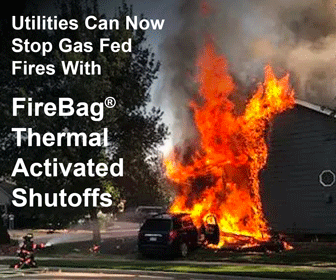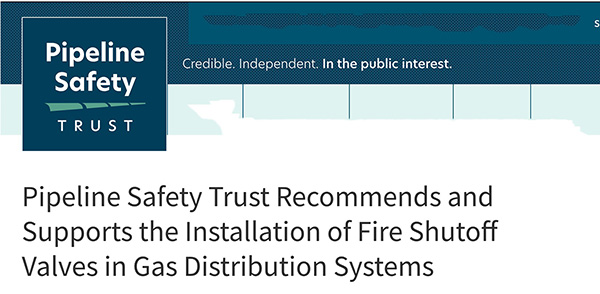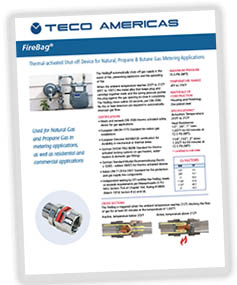Pipeline Safety Trust Strongly Recommends Fire Shutoff Valves in Gas Distribution Systems
Structures supplied with natural gas face significant fire hazards when the gas meters and regulators are compromised, as this adds high-pressure fuel directly to the fire. Once compromised, occupants and first responders face increased risks of injury and death, emphasizing the critical need to rapidly shut off the gas supply to the structure.
While manual gas shutoff valves have traditionally been used, automatic thermal shutoff valves—commonly known as Fire Safety Valves—provide a safer, faster, and more reliable solution. These devices quickly shut off the gas supply automatically in response to high temperatures from a fire.
Manual service line valves may become inaccessible or unsafe due to fire conditions, as evidenced by incidents like the Modesto, CA fire. Furthermore, manually shutting off a distribution line valve according to federal standards (49 CFR 192.181) can take an hour or more, significantly delaying rescue efforts. For example, during the deadly August 16, 2016 fire at the Flower Branch apartment complex in Silver Spring, Maryland, shutting off the gas took 1 hour and 14 minutes. Tragically, two young boys lost their lives because rescue operations were delayed until the gas supply was secured externally.
Similarly, in Birmingham, Alabama, on December 17, 2013, at a Public Housing fire, it took 3 hours and 45 minutes for first responders to find a debris-free path, locate the gas service line, and manually shut off the gas supply.
Delays in manual gas shutoff procedures often include:
- Notification of first responders
- Arrival of gas company representatives
- Coordinated response of first responders and utility crews
- Identifying and reaching the shutoff valve(s)
- Executing the shutoff
The Pipeline Safety Trust urges the widespread adoption of automatic thermal shutoff valves and recommends implementing federal regulations to mandate their use, enhancing the safety of building occupants and first responders nationwide.
The Pipeline Safety Trust is calling for the industry to adopt automated shutoff valves, which significantly reduce the time to shut off gas to the structure.
Sources:
https://pstrust.org/pipeline-safety-trust-recommends-and-supports-the-installation-of-fire-shutoff-valves-in-gas-distribution-systems/
https://pstrust.org/wp-content/uploads/2025/01/Fire-Shutoff-Valve-Position-Statement.pdf
View FireBag Video
Visit our video to get a fuller explanation and demonstration of where gas utilities install the FireBag for greater safety
Are Your Meter Sets Protected from Fire?
Share This Story
Resources
Contact Us Today!
All information is confidential and sent directly to a TECO Americas representative.
TECO® Americas, LLC
263 Cox Street Roselle, NJ 07203
inquiry@tecoamericas.com
Phone: 908-488-0909
https://tecoamericas.com





